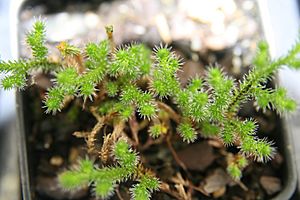Rock spike-moss facts for kids
Quick facts for kids Rock spike-moss |
|
|---|---|
 |
|
| Selaginella rupestris | |
| Scientific classification |
Selaginella rupestris, also known as the northern selaginella, is a special type of plant. People sometimes call it ledge spike-moss or rock spike-moss. It grows in dry, rocky places. You can find it in eastern North America, and even in one spot in Greenland.
This plant is quite amazing! When there isn't enough water, it can roll itself up into a tight ball. Because of this, it's sometimes called "bird nest moss." But don't worry, it's not dead! As soon as it touches water again, it opens right back up. This special ability helps it survive in very dry areas.
In the state of Indiana, this plant is considered to be in danger. This means it's "imperiled" or "threatened." It needs protection so that it doesn't disappear from those areas.
Contents
What is a Spike-Moss?
Spike-mosses are a group of plants that look a bit like mosses or ferns. They are not true mosses, though. They belong to their own special plant family called Selaginellaceae. These plants are very old, going back millions of years! They have small, scale-like leaves.
Where Does it Grow?
Selaginella rupestris likes dry, rocky spots. It often grows on cliffs, rocky slopes, or in open, sandy areas. Its range is wide across eastern North America. However, it doesn't grow everywhere in these areas. It pops up in specific places where the conditions are just right. This is why its range is called "sporadic."
How it Survives Dry Times
This plant is famous for its ability to "resurrect." When it gets very dry, its leaves curl up. The whole plant rolls into a tight ball. This helps it save water. It can stay like this for a long time. When rain comes, the plant absorbs the water. Then, it slowly unrolls and turns green again. This trick helps it live in places where water is scarce.
Why is it Important?
All plants play a part in their environment. Selaginella rupestris helps cover rocky areas. It can also help prevent soil from washing away. When a plant is "threatened," it means there are not many of them left. Protecting these plants helps keep nature balanced. It also means we can study their unique survival tricks.
See also
 In Spanish: Selaginella sellowii para niños
In Spanish: Selaginella sellowii para niños

